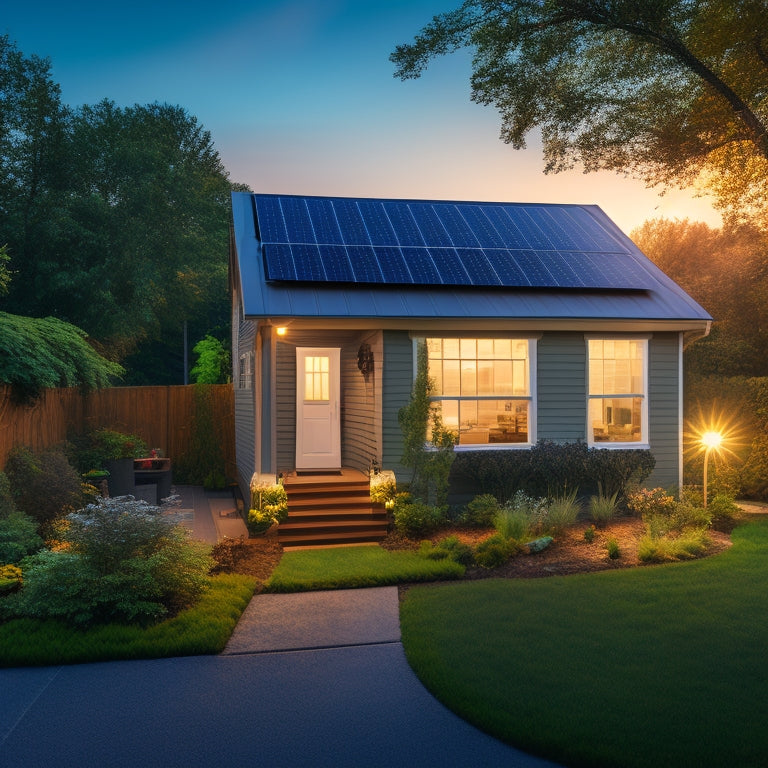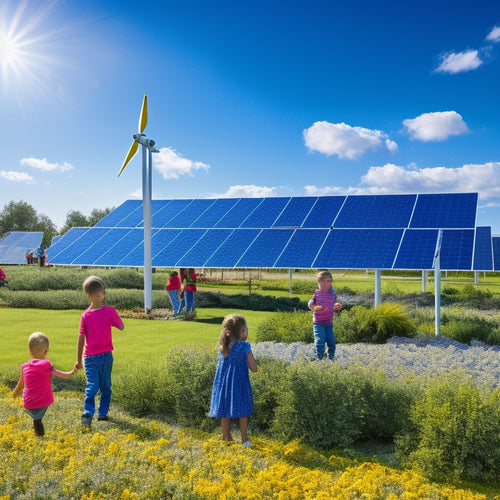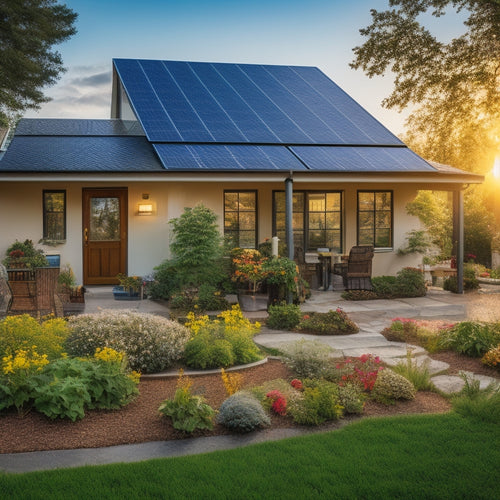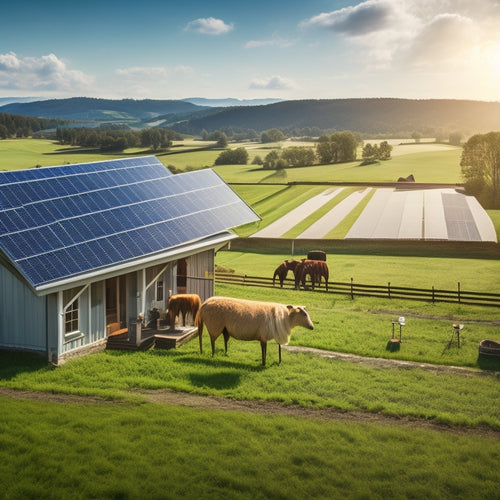
What Are the Best Low Cost Solar Power Options for Homeowners
Share
You're investing in a solar power system for your home, and you want to maximize your savings while minimizing upfront costs. To get started, consider affordable solar panel brands like Trina, Jinko, and Hanwha Q CELLS, which offer high-efficiency rates at lower costs. You can also investigate government incentives like the federal tax credit and local rebates to reduce your investment. Additionally, look into financing options like personal loans, community solar programs, and solar leasing agreements. By evaluating your options carefully, you'll be well on your way to utilizing the power of the sun while keeping costs low - and there's more to uncover as you continue to investigate your solar power options.
Key Takeaways
- Consider affordable solar panel brands like Trina, Jinko, and Hanwha Q CELLS that offer high efficiency at lower costs.
- Take advantage of government incentives like the federal tax credit and local rebates to reduce total installation costs.
- Explore financing options like personal loans, community solar programs, and solar leasing agreements to minimize upfront costs.
- DIY solar installation can save on labor fees, but ensure proper installation and maintenance for optimal energy production.
- Used solar panels can be a cost-effective option, but be aware of potential reliability issues and compatibility problems.
Solar Panel Costs Breakdown
Clarity is essential when it comes to understanding the financial investment required to harness the power of the sun. You're likely wondering what the costs entail and how to enhance your investment. Let's break it down.
Solar panel costs vary depending on the type and quality of the panels. You'll need to evaluate the wattage, efficiency, and durability of the panels, as well as the installation technique.
Monocrystalline silicon panels are the most efficient but also the priciest, while polycrystalline silicon panels offer a more affordable option with slightly lower efficiency. Thin-film panels are the most budget-friendly but have the lowest efficiency.
Installation techniques also impact the overall cost. You'll need to decide between a rooftop installation, ground-mounted system, or tracking system.
Rooftop installations are the most common, but ground-mounted systems offer more flexibility. Tracking systems, which adjust to follow the sun's movement, provide maximum energy output but are the most expensive.
Understanding the costs associated with solar panel types and installation techniques will help you make an informed decision about your investment.
DIY Solar Installation Benefits
Three primary benefits come with choosing a DIY solar installation: cost savings, increased control, and a sense of accomplishment. By installing the system yourself, you'll avoid the labor costs associated with hiring a professional, which can save you thousands of dollars.
Additionally, with a DIY installation, you'll have complete control over the design and implementation of your solar panel system, guaranteeing it meets your specific energy needs.
In addition, successfully completing a DIY solar installation project can give you a sense of satisfaction and accomplishment, knowing you've taken a significant step towards reducing your carbon footprint.
To guarantee a successful DIY installation, it's important to follow DIY installation tips and guidelines, such as evaluating your roof's suitability, selecting the right solar panels, and properly connecting the system to your electrical grid.
Moreover, regular solar panel maintenance is vital to guarantee peak energy production and extend the lifespan of your system. By doing it yourself, you'll also gain a deeper understanding of your system's inner workings, making maintenance and repairs more manageable.
Affordable Solar Panel Brands
As you've evaluated the benefits of a DIY solar installation, now it's time to investigate affordable solar panel brands that can help make your project a reality.
You'll want to focus on brands that offer high-quality panels at a lower cost without sacrificing panel efficiency.
Some affordable solar panel brands to examine include Trina, Jinko, and Hanwha Q CELLS.
Trina's panels boast an efficiency rate of up to 20.5%, making them a great option for homeowners with limited roof space.
Jinko's panels offer a range of efficiency rates, from 19.4% to 20.6%, and are known for their durability.
Hanwha Q CELLS' panels have an efficiency rate of up to 20.6% and are designed to provide maximum energy output.
When evaluating these brands, contemplate factors such as warranty length, durability, and certifications.
Look for brands that offer a 25-year warranty and have certifications like UL and IEC.
Government Incentives Explained
You can greatly reduce the cost of installing solar panels through government incentives.
The federal government offers a tax credit of up to 26% of the total installation cost, which you can claim on your taxes.
Additionally, many state and local governments offer their own incentives, such as rebates, tax exemptions, or property tax abatements, which can further lower your upfront costs.
Federal Tax Credits
Several federal tax credits are available to homeowners who invest in solar power systems, offering a significant reduction in their tax liability.
As a homeowner, you can take advantage of these federal incentives to offset the cost of installing solar panels.
Here are 3 key benefits to evaluate:
-
Solar Investment Tax Credit (ITC): You can claim a tax credit of 26% of the total cost of your solar power system. This credit can be claimed against your federal income taxes, reducing your tax liability.
-
The Residential Renewable Energy Tax Credit: This credit allows you to claim a tax credit for a percentage of the cost of qualified solar equipment, including solar panels and installation costs.
-
Net Metering: You can also benefit from net metering, which allows you to sell any excess energy generated by your solar power system back to the grid and receive a credit on your utility bill.
State and Local
Government support for solar power adoption doesn't stop at the federal level. As a homeowner, you can investigate state and local incentives to further reduce the cost of going solar. Many states offer additional tax credits or rebates, which can be combined with federal incentives.
You may also benefit from local regulations that exempt solar installations from property tax or provide special permits for solar installations. Some states have implemented solar programs, such as community solar initiatives, where you can invest in a shared solar array and receive a proportionate amount of electricity.
Utility partnerships can also provide discounts or special rates for solar-powered homes. Before installing solar panels, verify you comply with local zoning laws and regulations.
Research energy cooperatives in your area, which may offer exclusive benefits for members. By taking advantage of these state and local incentives, you can maximize your savings and expedite your shift to clean, renewable energy.
Solar Financing Options Available
Through innovative financing models, homeowners can now overcome the upfront cost barriers associated with solar panel installation. You're no longer limited by the high initial costs of going solar.
You have several options to investigate, including:
-
Personal loan options: Financing through credit or home equity loans can help you cover the upfront costs of solar panel installation.
-
Community solar programs: These programs allow you to invest in a shared solar array, providing you with a proportionate amount of the electricity generated.
-
Solar leasing agreements and power purchase agreements: These options enable you to benefit from solar energy without owning the system, reducing your upfront costs.
Additionally, you may be eligible for solar co-op benefits, green energy loans, or energy savings accounts, which can further reduce the financial burden of shifting to solar power.
Used Solar Panels Pros Cons
If you're looking to reduce the upfront cost of solar panel installation, considering used solar panels can be a viable option. You can save up to 50% on the overall cost of installation compared to buying new panels.
However, it's crucial to weigh the pros and cons before making a decision.
On the positive side, used solar panels can still provide reliable energy output, with some panels retaining up to 90% of their original efficiency. Additionally, reusing existing panels reduces waste and minimizes the environmental impact of manufacturing new ones.
You'll also contribute less to the growing problem of electronic waste.
On the other hand, used panel reliability can be a concern. You may not know the panel's maintenance history, and it may be more prone to failure. Warranties are usually void, and you might need to replace them sooner than expected.
Moreover, used panels may not be compatible with newer systems, which could limit their functionality.
Carefully evaluate the pros and cons before deciding if used solar panels are the right choice for your home.
Grid Tie Systems Advantages
When you install a grid tie system, you'll benefit from high energy efficiency, as it converts almost all of the DC power from your solar panels into usable AC power for your home.
You'll also take advantage of net metering benefits, which allow you to sell excess energy back to the grid and offset your electricity bills.
High Energy Efficiency
Grid tie systems boast high energy efficiency due to their ability to maximize your solar panel array's power output.
This means you can generate more electricity from the same amount of sunlight, reducing your reliance on the grid and your energy bills.
To get the most out of your grid tie system, it's crucial to optimize your home's energy usage.
Here are three ways to do so:
- Install energy efficient appliances: Replace traditional incandescent bulbs with LED bulbs and use power strips to plug in electronics, making it easy to turn them off when not in use.
- Improve home insulation: Confirm your home is well-insulated to reduce heat loss in winter and heat gain in summer, minimizing the need for heating and cooling.
- Conduct an energy audit: Hire a professional to identify areas in your home where energy is being wasted and provide recommendations for improvement.
Net Metering Benefits
As you generate electricity with your grid tie system, you'll want to maximize the benefits of net metering, which allows you to export excess energy back to the grid and offset your consumption during periods of low solar production.
With net metering, you'll receive energy credits for the excess energy you produce, which can be used to reduce your energy bills during periods of low solar production or at night.
One of the major net metering advantages is that it enables you to store excess energy in the grid, effectively using it as a virtual battery.
This means you can generate electricity during the day and use it at night or during periods of low solar production, reducing your reliance on the grid.
Additionally, net metering allows you to take advantage of time-of-use (TOU) rates, where you can sell excess energy back to the grid at a higher rate during peak hours and buy it back at a lower rate during off-peak hours.
Solar Power Kit Reviews
Solar power kits have become an appealing option for homeowners looking to harness renewable energy without breaking the bank. As you consider investing in a solar power kit, it's crucial to assess the features and efficiency of different options.
When reviewing solar power kits, you should prioritize the following key aspects:
-
Solar Kit Features: Look for kits with high-quality panels, durable mounting systems, and efficient inverters. Confirm the kit includes a monitoring system to track your energy production and consumption.
-
Solar Power Efficiency: Evaluate the kit's efficiency by considering the panel's wattage, voltage, and current output. Higher efficiency ratings indicate more power generated per unit area.
-
Certifications and Warranties: Verify that the kit meets industry standards and certifications, such as UL and IEC. Also, check the warranty offered by the manufacturer, which should cover the system's performance and components.
Local Solar Installers Comparison
When comparing local solar installers, you'll want to examine their installation cost breakdown to ascertain you're getting the best deal.
You should also investigate the quality of equipment used, as this can greatly impact your system's performance and lifespan.
Additionally, be certain to evaluate the warranty and support offered by each installer to guarantee you're protected in case anything goes wrong.
Installation Cost Breakdown
By examining the quotes from local solar installers, you'll likely notice significant variations in installation costs. This is because different installers use different installation methods, which affect the overall cost.
To break it down, here are some key factors to evaluate:
-
Labor costs: This is the largest component of installation costs, accounting for around 30% of the total. Look for installers who offer competitive labor rates or explore DIY installation options to save on labor costs.
-
Equipment costs: The type and quality of solar panels, inverters, and mounting hardware used can greatly impact the overall cost. Be sure to compare prices from different suppliers to find the best deals.
-
Permitting and inspection fees: These fees vary by locality, but can add up quickly. Research local regulations and factor these costs into your overall installation budget.
Understanding these cost factors will help you make an informed decision when choosing a solar installer.
Quality of Equipment Used
Digging into the quotes from local solar installers reveals that the quality of equipment used can vary considerably, affecting not only the upfront cost but also the long-term performance and durability of your solar power system.
As you compare quotes, you'll notice that different installers use different brands and models of solar panels, inverters, and mounting systems. These variations can impact the overall efficiency and reliability of your system.
When evaluating the quality of equipment, consider panel durability and performance metrics such as efficiency ratings, temperature coefficients, and warranty terms.
High-quality panels with higher efficiency ratings can generate more power per hour of sunlight, while durable panels with longer lifetimes can reduce maintenance costs over time.
Additionally, look for inverters with high conversion efficiency and strong monitoring capabilities to guarantee peak system performance.
Warranty and Support
You'll likely find that warranty and support services from local solar installers vary considerably, and it's essential to grasp these differences to confirm you're protected in case something goes wrong with your system.
When comparing local solar installers, pay attention to the warranty types they offer. Here are three key aspects to take into account:
-
System warranty: This warranty covers the entire solar panel system, including panels, inverters, and mounting hardware. Look for a minimum of 10 years' coverage.
-
Performance warranty: This warranty guarantees the system's energy production, usually for a specified percentage of the system's original output. A 25-year warranty is common.
-
Workmanship warranty: This warranty covers the installation quality, typically for 1-5 years. Confirm it's long enough to cover any potential installation issues.
Additionally, assess the quality of customer support offered by each installer. Do they provide 24/7 monitoring and maintenance?
What's their response time in case of an issue? A reliable customer support team can make a significant difference in your overall solar experience.
Energy Efficiency Upgrades First
Enhancing your home's energy efficiency is an essential step to take before investing in solar power, as it guarantees you're getting the most out of your future solar panel system.
You'll want to identify areas where energy is being wasted and make targeted upgrades to optimize your home's energy usage.
Start by conducting an energy audit to pinpoint energy-hungry appliances and inefficient systems. This will give you a clear understanding of where to focus your upgrade efforts.
Insulation upgrades are often a top priority, as a well-insulated home can greatly reduce energy loss. Upgrading your windows, sealing air leaks, and adding insulation to your attic and walls can make a big impact.
Frequently Asked Questions
Can I Install Solar Panels on a Shaded Roof?
You can still utilize solar power despite a shaded roof; consider installing a smaller system or exploring solar panel alternatives like solar shingles or building-integrated photovoltaics that accommodate shaded roof considerations.
Do Solar Panels Work During Power Outages?
Did you know that 70% of Americans experience a power outage each year? During outages, you'll remain powered with a solar battery, achieving grid independence; however, without a battery, your solar panels won't provide electricity, as they're designed to sync with the grid.
Are Solar Panels Damaged by Hail or Heavy Snow?
You're wondering if solar panels can withstand harsh weather. Fortunately, most modern panels are designed with hail resistance in mind, and snow accumulation is rarely a concern, as panels are typically installed at an angle to allow snow to slide off.
Can I Add Solar Panels to an Existing Roof?
You can add solar panels to an existing roof, but first, assess its suitability by checking age, condition, and structural integrity; then, the installation process typically involves a thorough inspection, mountings, and panel attachment, ensuring a secure and efficient energy harvest.
Will Solar Panels Increase My Property Taxes?
As you traverse the solar terrain, consider this: installing solar panels is like planting a tree - it adds value to your property, but you won't be taxed on the shade; in most states, your solar investment benefits won't impact property tax implications.
Conclusion
You've made it to the end of this solar power expedition, and what a bright idea that was! Ironically, the most cost-effective way to utilize the sun's energy is not to break the bank. By choosing affordable solar panel brands, leveraging government incentives, and exploring financing options, you can bask in the glory of renewable energy without draining your wallet. Now, go forth and soak up those rays – your wallet (and the planet) will thank you!
Related Posts
-

Solar Power for Community Energy Independence
Solar power is essential for your community's energy independence, offering both environmental and economic benefits....
-

How to Achieve Energy Independence at Home
To achieve energy independence at home, start by investing in renewable energy sources like solar panels, wind turbin...
-

Solar Power Systems for Rural Properties
Solar power systems offer a reliable and efficient energy solution for rural properties, allowing you to gain energy ...


